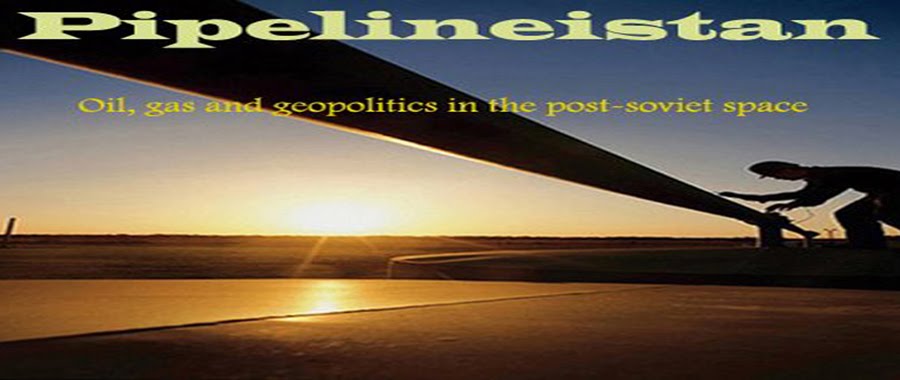 Russia expanded its foothold on the Asian energy market with the click of a mouse Monday [28th December].
Russia expanded its foothold on the Asian energy market with the click of a mouse Monday [28th December].Prime Minister Vladimir Putin pressed a button to get Siberian oil flowing into the first tanker for delivery to an Asian customer, in Hong Kong, from Russia’s Pacific coast. In addition to China, supplies will also target Japan and South Korea.
The ceremony completed four years of work to construct the East Siberia-Pacific Ocean pipeline and the Kozmino port, worth a combined 420 billion rubles ($14 billion) to ease the industry’s reliance on the European market.
“It’s a strategic project because it allows us to enter the completely new, growing and promising markets of the Asian-Pacific region,” Putin said at the launch. “It’s a great present to Russia for the New Year.”
The foray into the Asian oil market follows Russia’s arrival as a major supplier of liquefied natural gas, or LNG, for its eastern neighbors earlier this year. The Gazprom-led Sakhalin-2 project — with Shell, Mitsui and Mitsubishi as partners — started shipping the gas, chilled to a liquid for loading into tankers, from Russia’s offshore fields in the Pacific in February.
As it expands into new markets, Russia is keeping abreast of the global trend of diversification among both energy buyers and sellers, which will make the business more competitive worldwide, said Elena Shadrina, a visiting energy researcher at the Norwegian Institute for Defense Studies.
“No supplier or consumer will have a dominant position,” she said by telephone from Oslo.
Europe is trying to offset its dependence on gas imports from Russia by looking to buy more from Africa, while Turkmenistan began exporting its gas to China earlier this month, ending Russia’s role as its only major buyer. Asia, in turn, has been seeking alternatives to supplies from the Middle East.
Russia’s progress in eastward expansion has been spectacular, defying doubts that the country has sufficient oil reserves and investment, Shadrina said.
“As little as five years ago, I heard skeptical attitudes from Japanese officials and analysts,” she said. “The tone has really changed now.”
The Kozmino port, near Vladivostok, cost $2 billion to build and has the capacity to handle 300,000 barrels of crude per day (15 million tons per year), with oil quality comparable to that of Middle Eastern blends now dominating the market.
Transneft, the state pipeline monopoly, spent another $12 billion to lay the 2,694-kilometer ESPO pipeline through east Siberian wilderness to connect the area’s greenfields, being developed by oil majors Rosneft, TNK-BP and Surgutneftegaz, to the railway station of Skovorodino. The link has the capacity to carry 30 million tons a year.
Arriving in Skovorodino, the crude is loaded onto trains to travel to the port by rail.
Transneft plans to start building the rest of the pipeline to Kozmino, which requires an estimated investment of $10 billion, next year and complete the work in 2014. The effort will bring the link’s total length to 4,794 kilometers, which is more than the distance from New York to Los Angeles.
When completed, the pipeline will carry eastward an annual 80 million tons of oil from Siberia, including 15 million tons to China through an additional spur. China has loaned $25 billion to Russia in exchange for oil deliveries over the next two decades. Kozmino will increase capacity to 600,000 barrels per day, or 30 million tons per year.
Seeking the huge investment for the remote east Siberian greenfields that are to feed the pipeline, Russia will likely ease access to these resources by foreign oil majors, said Shamil Yenikeyeff, a researcher at the Oxford Institute for Energy Studies. A law enacted last year allows the government to take away a field from a foreign company if it strikes large oil reserves there during exploration, a restriction that put off potential investors, such as Royal Dutch Shell.
Yenikeyeff said Russia’s emergence this year as an Asian energy power — while being a wise policy — displayed the country’s continuing reliance on oil and gas exports for economic prosperity.
“You may call this a new era,” he said, referring to the unlocking of new markets. “The question is: Does this mean that Russia will grow even more affected by the oil curse? If you look at the other industries, nothing is happening there.”
The first tanker’s crude that left Kozmino belongs to state-controlled Rosneft and represents a new oil blend named ESPO, after the pipeline. The low-sulphur, medium-heavy sweet blend ranks higher than Russia’s main export blend, Urals, but its quality is going to be unstable for a while as more producers pump their oil in the pipeline.
The price of the crude is tentatively based on the average monthly price of the Middle Eastern benchmark Dubai blend, with the option for traders to offer a discount or premium. Rosneft sold the first shipment to the Finnish trader IPP Oy at a premium of 50 cents.
(The Moscow Times)
